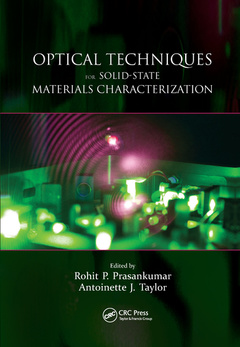Description
Optical Techniques for Solid-State Materials Characterization
Coordinators: Prasankumar Rohit P., Taylor Antoinette J.
Language: English
Subjects for Optical Techniques for Solid-State Materials...:
Keywords
Probe Pulse; Pump Pulse; pump; Pump Probe Experiment; pulse; Correlated Electronic Materials; probe; Kerr Rotation; photon; PL Spectrum; energy; Excitation Pulse; american; Pump Beam; physical; Probe Beam; society; Optical Constants; beam; Pump Probe Delay; parametric; THz Pulse; Probe Photon Energy; Phase Matching; Mode Locking; Optical Pump THz Probe; Spectral Diffusion; ARPES Experiment; Eo Sampling; THz Generation; Transition Metals; Raman Scattering; Differential Reection; PL Emission; Photon Echo
Publication date: 06-2020
· 17.8x25.4 cm · Paperback
Publication date: 07-2011
664 p. · 17.8x25.4 cm · Hardback
Description
/li>Contents
/li>Readership
/li>Biography
/li>
Over the last century, numerous optical techniques have been developed to characterize materials, giving insight into their optical, electronic, magnetic, and structural properties and elucidating such diverse phenomena as high-temperature superconductivity and protein folding. Optical Techniques for Solid-State Materials Characterization provides detailed descriptions of basic and advanced optical techniques commonly used to study materials, from the simple to the complex. The book explains how to use these techniques to acquire, analyze, and interpret data for gaining insight into material properties.
With chapters written by pioneering experts in various optical techniques, the text first provides background on light?matter interactions, semiconductors, and metals before discussing linear, time-integrated optical experiments for measuring basic material properties, such as Fourier transform infrared spectroscopy, photoluminescence, and Raman scattering. The next section begins with a description of ultrashort pulse generation and carrier dynamics in semiconductors and metals. The book then discusses time-resolved optical techniques, such as pump?probe spectroscopy, terahertz spectroscopy, and magneto-optical spectroscopy. The subsequent section describes spatially resolved optical spectroscopy, including conventional optical microscopy and micro-optical and near-field scanning techniques. The book concludes with an overview of more advanced, emerging optical techniques, such as ultrafast x-ray and electron diffraction, ultrafast photoemission spectroscopy, and time-resolved optical microscopy.
As optical techniques are among the first applied when studying new systems with novel properties, the information presented in this comprehensive reference will only grow in importance. By supplying clear, detailed explanations of these techniques, the book enables researchers to readily implement them and acquire new insights into the materials they study.
CRC Press Authors Speak
Rohit P. Prasankumar speaks about his book. Watch the Video
BACKGROUND: Light-Matter Interactions. Semiconductors and Their Nanostructures. The Optical Properties of Metals: From Wideband to Narrowband Materials. LINEAR OPTICAL SPECTROSCOPY: Methods for Obtaining the Optical Constants of a Material. Methods for Obtaining the Optical Response after CW Excitation. Raman Scattering as a Tool for Studying Complex Materials. TIME-RESOLVED OPTICAL SPECTROSCOPY: Ultrashort Pulse Generation and Measurement. Carrier Dynamics in Bulk Semiconductors and Metals after Ultrashort Pulse Excitation. Ultrafast Pump-Probe Spectroscopy. Transient Four-Wave Mixing. Time-Domain and Ultrafast Terahertz Spectroscopy. Time-Resolved Photoluminescence Spectroscopy. Time-Resolved Magneto-Optical Spectroscopy. Time-Resolved Raman Scattering. SPATIALLY RESOLVED OPTICAL SPECTROSCOPY: Microscopy. Micro-Optical Techniques. Near-Field Scanning Optical Microscopy. RECENT DEVELOPMENTS: Recent Developments in Spatially and Temporally Resolved Optical Characterization of Solid-State Materials. Index.
Rohit P. Prasankumar is a technical staff member in the Center for Integrated Nanotechnologies at Los Alamos National Laboratory. He earned a Ph.D. in electrical engineering from the Massachusetts Institute of Technology. His research focuses on the measurement of dynamics in complex functional materials with high temporal and spatial resolution over a broad spectral range.
Antoinette (Toni) J. Taylor is the leader of the Materials Physics and Applications Division at Los Alamos National Laboratory (LANL), where she was awarded the Los Alamos Fellow’s Prize for Outstanding Leadership in Science and Engineering. She is a fellow of LANL, the American Physical Society, the Optical Society of America, and the American Association for the Advancement of Science. Her research interests include the investigation of ultrafast dynamical nanoscale processes in materials and the development of novel optics-based measurement techniques for understanding new phenomena.




